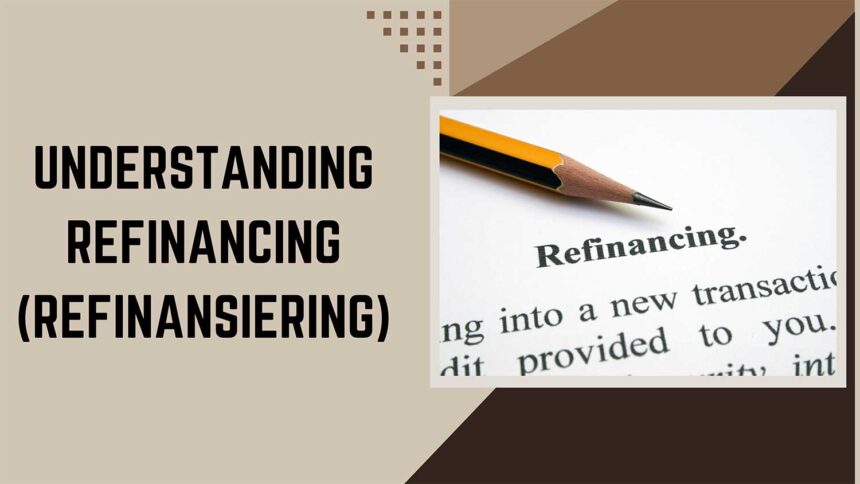One issue that has plagued and continue to plague a lot of people financially is debts. We believe that people get into so much debt because of the ease of access to loans in all forms and with different terms and conditions.
From online lenders to banks and financial institutions, people have access to credit advance that can be used for various purposes. From buying a car or house to financing a trip abroad or seeing a child through school; there are different financial product s that are tailored to meet these needs.
The issue now arises when consumers receive these funding and are not able to manage the debt well. Some may be due to carelessness or multiple debts. Our focus in this article is not really on how people end up in crippling debt but on how to get out of it. You can check out this site for practical ways to get out of debt. https://www.investopedia.com/
But in this article we will discuss the basics of refinancing in order to help you understand this method of getting out of debt.
Basics Of Refinancing
Refinancing or refi for short is the process through which a consumer replaces an existing loan with a new one that has better terms and conditions. This credit facility comes in handy especially when a borrower is swamped with multiple debts. It is a great way of getting out of debts faster and in the process probably save some money.
Types of Refinancing
There are different options for refi loan and the consumer will determine which option they want to go for based on their specific needs. Below, we discuss some of these options:-
Rate And Term Refinancing
This option is one in which the existing loan is replaced with a new one with lower interest rate. It is the most known and used option of refi. The new loan is used to pay off the old loan and then the borrower continues servicing the new loan based on the new agreement.
Cash Out Refinancing
This type is common with secured loans that the value of the collateral backing the loan has increased. This process involves using the equity in the home to get a higher amount and most often it comes with higher interest rate.
What this means is that when the value of a property increases, the owner can cash out the value of the property through a loan instead of selling the property. Although this will increase the total amount the borrower has to pay back eventually, it provides immediate cash for the person while they still maintain ownership of the property.
Cash In Refi
As the name implies, this is like an opposite of the cash out. In this case, the borrower pays down part of the money owed in order to get smaller monthly payments or a lower LTV (loan to value) ratio.
Consolidation
In this option, the borrower gets one loan at a lower interest rate to pay off several debts. This interest rate is usually lower than the average rate of all the debts put together. So the borrower gets this single loan and pays off all the others and then begins to pay off the outstanding principal at a much lower interest rate. Click here for more information on consolidation refi.
Why Refinance?
There are several reasons why a borrower may decide to refinance their debt and it includes the following:-
- Ability to move from an adjustable rate mortgage to a fixed rate or the reverse.
- Lowering of fixed interest rate in order lower the monthly repayments
- Changing the repayment duration and terms.
- A shift in the economic climate
- Improved credit score
This brings us to exploring the advantages and disadvantages of refi loans.
Advantages
- Better Management of Payment – The reason why some people even get into the debts that make them need a refi loan is because they had multiple debts and didn’t manage it well. But with an option such as consolidation refi, the borrower will only have one loan to service. This means that they wouldn’t forget to make a particular payment and they can adhere faithfully to their payment plan.
- Better Terms- Refinancing presents the borrower with the opportunity to negotiate a loan with better terms such as lower interest rate.
- Fewer Fees – Multiple loans translates to multiple fees especially when you do not make your payments as at when due. But with a single loan, you just have fees for that loan.
- Lower Monthly Total – Following from the point above, when you calculate the cost of multiple monthly payments, you will discover that you will be paying much more than you envisaged. But with a refi, your monthly cost is reduced significantly.
- You Can Become Debt Free Faster- If you adjust your repayment period to a shorter term, you can become debt free a lot faster.
Disadvantages
- The fees that come with the refi may make the whole process not worth it.
- It might affect your credit score negatively.
- You might have to start making higher monthly payments.
- The savings you make might not be with the hassles that you go through to get the loan.
Credit Limit For Refi Loans
There are many factors that can affect hvor mye (how much) you can get for refinancing. One of the major factors is whether you are applying with collateral or not.
If you are refinancing a mortgage you take out the loan against the value of the home and the rule is that the amount must not be more than 85% of the value of the home. The value of the home therefore serves as the collateral for the refi loan.
In the case of refinancing without collateral, you have to apply for a consumer loan designed specifically for that purpose. The credit limit for this is usually the same as for every other type of consumer loan which is as much as NOK 600,000. Individual banks however, have their parameters for setting limits. This is so that the borrower does not take a refi loan that is higher than the original debt.
How Are Refi Loans Disbursed?
Sometimes borrowers may want to play a fast one and take out a refi loan without using it for the stated purpose. For this reason, many banks usually pay out all the claims for the customer. Furthermore, some customers may have problems dealing with all the debts by themselves. So all they need to do is to send the correct and up to date details on all the loans that are to be paid and the bank will take care of everything.
In the event that the amount granted exceeded the total debts owed, the bank will pay the balance into the borrower’s account. The above process saves the customer the stress of sorting out all the payments and also the temptation of withholding some payments.
Conclusion
Sometimes people find themselves in financial quagmire that they didn’t expect. There are various ways that one can get out of these financial pitfalls but we have looked at just one and that is refinancing. We believe that the information shared here has shed some light on the subject and you now know the basics of refinancing.









